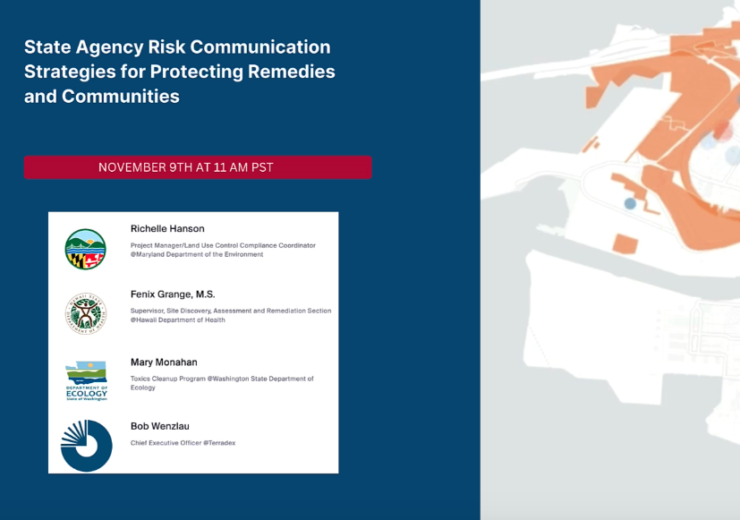There are hundreds of thousands of brownfield sites throughout the United States. Proactively monitoring activity on those properties is the best way to promote long-term land stewardship, a point featured in the Terradex webinar “State Agency Risk Communication Strategies for Protecting Remedies and Communities”.
Changes in property ownership, environmental contamination, and a lack of knowledge and clear communication about potential risks are all challenges to safe, long-term land stewardship. Terradex DigClean provides an efficient solution to all these challenges, allowing state regulators to effectively monitor who owns what parcel of land and what activity is being done there. As an automated monitoring and advisory service, DigClean allows state environmental agencies to track hundreds of contaminated sites and notify impacted parties about potential risks, like the dangers associated with excavation.
Excavation is often the greatest risk to brownfield sites
Several state agencies discussed how they’ve utilized DigClean. Here are several top takeaways about the benefits of using this technology solution:
- Effective enforcement tool that pays for itself. The Maryland Department of the Environment (MDE) started using DigClean in 2019. MDE issued three notices of violation (NOV) three years later, with penalties totaling $31,500, its first NOVs since 1999.
- Efficiently leverages staff and resources. DigClean automatically monitors for changes in land ownership. In Washington state, DigClean also monitors environmental covenants tied to specific properties. Terradex then flags property sales and sends new owners a letter that mentions the environmental covenant. That makes it easy for the Washington Department of Ecology to communicate with landowners about land use requirements.
- Provides important land use information to landowners. Environmental covenants aren’t always communicated to new property owners, which is why Terradex is such a powerful tool.. Owners need to understand what covenants are on their property to know what use restrictions are in place.
- Helps contractors and owners avoid compliance violations and hefty fees. When MDE received a DigClean advisory about a shade structure installation at a daycare chain, Richelle Hanson (MDE) immediately saw a red flag because there shouldn’t even be a daycare on that property. MDE conducted an immediate site inspection and found that an excavator had already dug multiple holes to put in the shade structure. Additionally, there were three other schools on the property that violated commercial/industrial use restrictions. MDE contacted the property owner and issued penalties. Those penalties would have been much higher if MDE hadn’t detected the shade structure and immediately acted on that information.
- Supports government public safety and environmental health efforts. The Hawaii Department of Health uses DigClean to address sites with environmental hazard management plans and hazardous munitions via the one-call system. The goal is for excavators to be aware of the hazards presented by different types of sites and to use that information to evaluate the impact of excavation before digging into the ground.
- Supports environmental justice priorities. One of the reasons that Washington uses Terradex is to keep government officials aware of what’s happening in their communities, said Mary Jo Monahan (Washington Department of Ecology). That knowledge enables them to focus on and address environmental justice issues.
Conclusion
Technology solutions like DigClean have played a significant role in long-term stewardship and risk communication to all interested parties, including communities, on or near contaminated sites. The application has utility for state (and federal) agencies beyond the uses we originally envisioned; things like PFAS and environmental justice were not yet on the radar at DigClean’s inception. We now see states using the technology to address the next generation of stewardship challenges. This innovation is paving the way for replication in other states, as well as federal agencies with overlapping oversight responsibilities for these same lands and geographies.
The success of DigClean in protecting remedies and people is gratifying; we hope that Terradex technologies can bring the needed efficiencies to any state and federal government agency charged with land stewardship and community protection in perpetuity.

